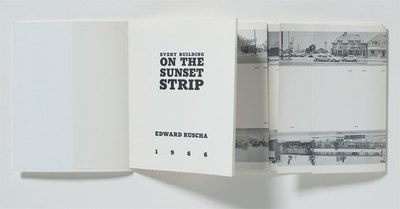Online-Vortrag // Michael Diers: URBANOTOPIA. On Word and Image and Some Political Aspects in Ed Ruscha's Every Building on the Sunset Strip (1966)
Sunset Boulevard is one of the most famous streets of Los Angeles, the so-called Sunset Strip between West Hollywood and Beverly Hills its most prominent section. Bars, boutiques, casinos, music and nightclubs have been located here since the 1920s. This is where Hollywood stars used to meet, but in the 1960s it was a celebrated venue for the rock and pop scene, especially for young people, and soon became a center of counterculture. Ed Ruscha's famous photographic artist's book "Every Building on the Sunset Strip" (1966) has erected a monument to this street in the form of a 7.60-meter-long leporello that is both worth seeing and reading. It has been part of the canon for a long time, has been examined frequently, but there are still some questions that have not yet been asked. For example, about the relationship between word and image in this picture book without words or about the political associations that result from a close reading.

Michael Diers, art historian and critic, has been Professor for Art History and Visual Studies at the University of Fine Arts in Hamburg and Extraordinary Professor for Art History at the Humboldt University of Berlin. His research focuses on Renaissance Art, modernism and contemporary art, photography and new media, art und media theory, political iconography and history of science. He has written many essays and books on the aforementioned topics, among them „Warburg aus Briefen“ (1991), „Schlagbilder. Zur politischen Ikonographie der Gegenwart“ (1997), „Hans Haacke, ‚Der Bevölkerung’“ (2000, co-editor with K. König), „Film, Fotografie, Video. Beiträge zu einer kritischen Theorie des Bildes“ (2006), „Topos Atelier. Werkstatt und Wissensform“ (2009, co-editor with M. Wagner); „Das Interview. Formen und Funktionen des Künstlergesprächs seit Vasari“ (2013, co-editor with L. Blunck and H.U. Obrist); “Max Liebermann: Die Kunstsammlung. Von Rembrandt bis Manet” (co-editor, with B. Hedinger and J. Müller, 2013); “Vor aller Augen. Studien zu Kunst, Bild und Politik” (2016). He is co-editor of the Collected Writings of Aby Warburg and coeditor of Warburgs “Kleine Schriften und Vorträge” (with C. Wedepohl) and “Briefe, 1886-1929” (with S. Haug), both volumes forthcoming 2020/21, and was the longstanding editor of the paperback series „kunststück“ and „Fundus“. In addition, he works as a freelance writer for the German newspapers Frankfurter Allgemeine Zeitung”, Süddeutsche Zeitung” und DIE ZEIT. He lives in Berlin.
_________
Der Vortrag ist Teil der Veranstaltungsreihe “California Dreaming: Utopia, Dystopia” des Lehrstuhls Theorie und Geschichte für Architektur, Kunst und Design der Technischen Universität München und des Zentralinstituts für Kunstgeschichte.
Die Vortragsreihe "California Dreaming. Utopia, Dystopia" findet via Zoom statt unter der Meeting ID 918 9364 6015. Eine einmalige Registrierung ist notwendig, damit Ihnen das Passwort für alle Vorträge mitgeteilt werden kann. Bitte senden Sie eine E-Mail mit Ihrem Namen und dem Betreff "Registrierung" an california@zikg.eu. Ihre E-Mail-Adresse wird zu keinem anderen Zweck als dem genannten verwendet und nach Ende der Vortragsreihe gelöscht.
Der Zugriff auf die Vorträge in den Zoom-Meetings ist auf 300 Teilnehmende begrenzt.
Abbildungsnachweis: Ed Ruscha, Every Building on the Sunset Strip, 1966, Privatbesitz
